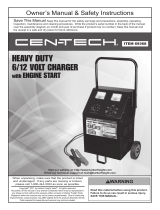
i
Congratulations on the purchase of your new battery charger. We wish to
acknowledge Underwriters Laboratories (U/L) for contributing the fol-
lowing important safety precautions. Please read and retain
t
hese
instructions for the continued safe use of your new charger.
This manual contains important safety information. DO NOT OPERATE
this equipment UNTIL YOU HAVE READ this safety summary!
IMPORTANT SAFETY INSTRUCTIONS.
SAVE
THESE INSTRUCTIONS
SAFETY
INFORMA
TION
The following safety information is provided as guidelines to help you
operate your new battery charger under the safest possible conditions.
Any equipment that uses electrical power can be potentially dangerous
to use when safety or safe handling instructions are not known or not
followed. The following safety information is provided to give the user the
information necessary for safe use and operation.
A procedure step preceded by WARNING is an indication that the next
step contains a procedure that might be injurious to a person if proper
s
afety precautions are not heeded.
A procedure preceded by a CAUTION is an indication that the next step
contains a procedure that might damage the equipment being used.
A NOTE may be used before or after a procedure step to highlight or
explain something in that step.
SHOCK HAZARDS
1. This battery charger is intended for indoor use only. Do not expose
the charger to rain or snow.
2. NEVER attempt to charge a marine (boat) battery while the boat is
on or near the water. A boat must be on a traile
r and located indoors
before attempting to charge its battery(s). The boat
manu
f
ac
t
urer’s
battery charging instructions must be followed exactly.
3. NEVER set the charger, output cable or clamps, or ac power cord
plug in water or on wet surfaces.
4. NEVER use this charger on a pier or dock. Charger could fall
in
water, creating an electric shock hazard.
5. NEVER attempt to plug in or operate the battery charger with defec-
tive or damaged wires, power cord, or power cord plug. Have any of
these parts that are defective or damaged replaced by qualified per-
sonnel IMMEDIATELY.
6. NEVER attempt to plug in the charger or operate its controls with wet
hands or while standing in water.
7. NEVER alter the ac power cord or power cord plug provided with the
battery charger.
8. NEVER use an attachment not recommended or sold by the battery
charger charger.manufacturer for use with this specific model battery
9. NEVER operate this battery charger if it has received a sharp blow,
been dropped, or similarly damaged, unt
il after being inspec
t
ed
and/or repaired by qualified service personnel.
10. NEVER disassemble this battery charger. Take the battery charger
to qualified service personnel when service or repair is needed.
11. ALWAYS plug in and unplug the ac power cord by grasping t
he
power cord plug, NOT THE POWER CORD, to reduce risk of dam-
aging power cord.
12. ALWAYS remove personal metal items such as rings,
bracele
t
s
,
and watches when working with a lead-acid battery. A
lead-acid
battery can pr
oduce a short circuit current high enough to weld a ring
or any jewelry to metal causing a severe burn.
13. ALWAYS unplug the battery charger from the ac outlet
be
f
ore
attempting any cleaning or maintenance. Turning the charger’s con-
trol(s) OFF, alone, will not remove all electricity from the charger.
14. An extension cord should not be used unless absolutely necessary.
Use of an improper extension cord could result in a fire or elec
t
ric
shock. If an extension cord
must be used, make sure that:
a. the pins on the plug of the extension cord are the same number,
size, and shape as those of the plug on the charger,
b. the extension cord is properly wired and in good electrical condi-
tion, and
c. the wire size is large enough for the length of cord as specified in
the following chart:
Length in feet: 25 50 100 150
cord AWG size: 18 18
16 14
EXPLOSIVE GAS HAZARDS
1. Working in the vicinity of a lead-acid battery is dangerous. Batteries
generate explosive gasses during normal operations and, at an even
higher level, during charging.
If anything is allowed to ignite these gasses, the battery may
explode, sending pieces of the battery and extremely caustic battery
acid out in all directions and with extreme force. Since just the slight-
est spark is sufficient to ignite these gasses, it is of U
T
M
OST
IMPORTANCE that you read this manual and follow the instructions
exactly, before using your battery charger each time.
2. NEVER operate this battery charger near any fuel tanks or gas cylin-
ders. This charger can produce sparks that could ignite gasses and
cause an explosion.
3. NEVER attempt to permanently mount this battery charger on a
marine or recreational vehicle.
4. NEVER attempt to connect this charger’s output cables directly t
o
the battery(s) in the bilge or engine compartment of a boat. Follow
the boat manufacturer’
s battery charging instructions exactly
SAFETY
















